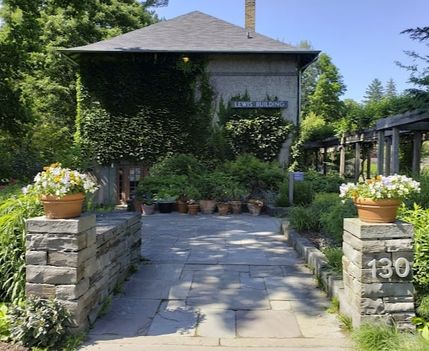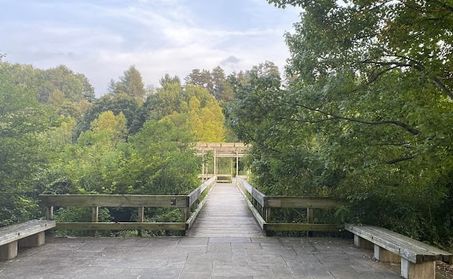
Next to the Cornell University Campus is your next favorite nature stop. Cornell Botanical Gardens is a place with endless beautiful maintained gardens and well-paved roads that are dog-friendly. Fantastic in all seasons and free to enter, what more can you ask for?
History
Before Cornell University was founded, Ezra Cornel had a large farm she donated to be used in the University. When they built the first women’s dormitory in 1875, It included an area to grow plants and a small tree collection. As early as 1888, the university began acquiring lands nearby to preserve them for the educational opportunities they provided the students.
The University wanted the best collections of everything, libraries, and botanical gardens. Over time, more gardens, Arboretums, and plant collections were added to what people grew to call the “Cornell Plantations.” The name was changed to Cornell Botanical Gardens after the original name was deemed racially insensitive.
The Gardens
Cornell Botanical gardens include vast collections of well-kept gardens showcasing different plants. There are gardens dedicated to all sorts of plant life here. Some of them include:
Class of ’53 Container Gardens and Tropical Garden Beds
These garden beds are the summer feature of interest infront of the Nevin Welcome center and next to the Lewis building. They feature colorful tropical annual plants with luscious foliage and bold flowers.
The garden evokes an appreciation for the tropics and transports you to the rainforest floor. Don’t miss the crazy colors and showy leaves.
Zucker Shrub Collection
A secret garden within the boundaries of Cornell Botanic Gardens, the Zucker Shrub collection is a tranquil spot. Featuring several different local and exotic shrubs growing together in beds surrounded by grass, it’s a fantastic view. The entrance is lined by lilies, welcoming visitors to explore and study interesting shrubs arranged thoughtfully and maintained well.
Cornell Class of 1938 Native Maple Slope
Just northwest of Newman Overlook, you’ll find slopes showcasing maple trees native to the State of New York. The tree varieties were specially selected for their exceptionally beautiful fall foliage. You don’t want to miss this spot when the seasons change. The gorgeous colored foliage can be seen on maples like:
- Red Maple
- Sugar Maple
- Silver Maple
- Striped Maple
- Globosum Sugar Maple
The collection of trees is part of an effort to preserve the germplasm of native and historical plants. Along with the trees mentioned above, you’ll find all sorts of interesting varieties.
Robison Herb Garden

Ellis H. Robison gifted his wife, a learned gardener, Doris Burgess Robison, a garden in 1947. This garden has an impressive seventeen themed beds showcasing over five hundred different herbs. You will find medicinal, fragrant, and culinary herbs and learn much about them. Rare exotic herbs from other countries are there too.
Young Flower Garden
John Young Cornell donated this garden in loving memory of his wife in 1981. The garden is a celebration of love of all kinds. Relationships that bind us help us thrive.
It showcases flowers with different meanings in culture, literature, and legends. The garden is breathtakingly beautiful in the spring. Just like spring, nothing lasts forever. The garden reminds you to cherish those close to you at the moment and remember them fondly once they’re gone.
North Walk
This garden features different flowering and non-flowering ground covers. You can explore the different plants while walking the path, starting from the Lewis building and ending at Judd Falls Road. The path also features perennials from all over the Americas.
Hillside Garden
The hillside garden is a piece of functional horticulture. It shows different spreading groundcovers and shrubs grown as groundcovers. They are specifically chosen to stabilize the slope above the herb and winter gardens.
You can learn how plants can be used to preserve the hillside and prevent landslides. Appreciating this garden is an educational experience.
Mullestein Winter Garden
Next to the Young Flower Garden lies its stark contrast, Mullestein Winter Garden. The plants that adorn this one-acre large area are chosen because they look the best when it snows. Plants with interesting bark colors and textures or evergreen leaves are arranged appealingly. Winter berries provide color to the blank snowy canvas.
This garden is open all year round. In fact, the best time to see it is during the winter. It’s nice in the summer, but its true beauty is when all its leaves are gone. The ethereal landscape is the stuff of fantasy stories.
Comstock Knoll and Rhododendron Collection
The Knoll was formed by ancient glacial activity, much like the hills and lakes of the Catskills and Finger Lake regions of New York. It was named after Cornell professors John and Anna Comstock.
During the Spring months, it is covered in flowers entirely. It’s a beautiful sight that inspires artists like painters, writers, and photographers on and off campus. The flowers include:
- Red, Yellow, Pink, and White Rhododendron
- Several Types of Hosta
- Flowering Trees, Ferns, and Perennials.
